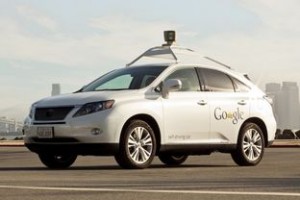In discussions about the emergence of automated and connected vehicle travel, it’s the technology that tends to attract most of the attention and fascination, but that technology also presents significant implications for policy makers. The TTI Transportation Policy Research Center is working to better understand those implications and inform the decision making that will influence how automated travel can come about in a way that best serves the public interest. The Revolutionizing our Roadways series outlines the PRC’s work related to public policy and cybersecurity considerations, and researchers will publish another series installment on the issue of privacy this summer.
Google Testing Self-Driving Vehicles in Austin
by Aman Batheja, The Texas Tribune |
 After years of experimenting with its groundbreaking autonomous vehicle technology almost exclusively in California, Google confirmed Monday that it has begun testing one of its self-driving vehicles in Austin.
After years of experimenting with its groundbreaking autonomous vehicle technology almost exclusively in California, Google confirmed Monday that it has begun testing one of its self-driving vehicles in Austin.
A white Lexus RX 450h SUV outfitted with the company’s sensors and software began making trips without the aid of a driver in the city within the past week, said Jennifer Haroon, head of business operations for the Google self-driving car project. Another vehicle will join it in the area for testing this week.
While California and other states have updated their laws to address self-driving vehicles, neither Texas nor Austin has followed suit, meaning Google did not need to get permission before initiating such testing in the city. Company officials briefed Gov. Greg Abbott’s office, Austin Police Chief Art Acevedo and the city of Austin about the testing in advance, Haroon said. No public funds are involved in the testing, and the company is not providing any funding to local or state entities related to the testing.
The expansion of the project to Texas comes as the company’s experimental fleet has safely logged over a million miles and its software has matured to be able to simultaneously detect hundreds of different activities going on around a vehicle, Haroon said. Two “safety drivers” will be in each of the vehicles whenever traveling in Austin in self-driving mode.
“They’re there to see how the vehicle is behaving, provide feedback to our engineering team and, if needed, take over [driving],” Haroon said.
Until now, Google’s vehicle testing has mostly centered around the San Francisco area, where the technology giant is based. The new testing will be focused in an area north and northeast of downtown Austin, according to company officials. The cars will not drive autonomously on any area highways, for now. Google officials are hoping Austin will provide its self-driving vehicles with an environment different from what researchers have already explored in recent years.
“We think there may be some geographic differences,” Haroon said. “There could be some differences in driver/pedestrian/bicyclist behavior. We really won’t know until we’ve started testing more.”
The vehicle testing is the latest sign of Google’s embrace of tech-savvy Austin. Along with having offices in the city, the company selected Austin as one of the first cities to roll out its high-speed Internet project, Google Fiber.
Speculation that self-driving tests were underway in Austin emerged last month following public sightings of one of Google’s Lexus SUVs with sensors attached to it. According to company officials, Google employees were driving the vehicle around to map out the area in detail, currently a necessary step before it can drive autonomously among pedestrians and other drivers.
“It makes the task of self-driving easier on the car so that the car can really focus on what’s novel and new in the environment,” like pedestrians and construction zones, company spokeswoman Courtney Honhe said.
Google released statements of support Monday from local public officials as well as Texas Department of Transportation Executive Director Joe Weber.
“As TxDOT focuses its efforts on the reduction of congestion and highway safety, we welcome and support Google’s autonomous vehicle test within the state of Texas,” Weber said “The successful integration of driverless trucks and cars on to our current and future transportation network could be a key factor toward achieving safe and reliable transportation.”
Acevedo added, “Keeping Austin’s roads safe is one of our highest priorities, so we look forward to seeing how self-driving car technology might someday improve traffic safety.”
This isn’t the first time one of Google’s self-driving cars has popped up in Austin. An earlier prototype was the star of a transportation conference hosted by TxDOT in 2013, giving rides on Interstate 35 to local and state officials.
During this year’s legislative session, lawmakers filed bills aimed at encouraging the use of the technology in Texas while allowing for some government oversight. None passed. A measure by state Sen. Rodney Ellis, D-Houston, would have created a pilot program to encourage testing of the technology in the state while also developing some minimum safety requirements for autonomous vehicles. Google opposed the bill but refused to provide a public explanation for its opposition. (An organization representing automobile manufacturers also opposed the bill, citing concerns that state-specific standards could slow down innovation.)
Haroon said Monday that there was no connection between the company’s plans to test its technology in Austin and its opposition to Ellis’ bill.
“We don’t think new laws are necessary at this stage and in fact that could be harmful to innovation,” Haroon said. “We’re still learning how the technology might be used.”
Google recently began releasing monthly reports listing accidents involving its self-driving vehicles. Haroon said the company would include any Austin accidents in future reports, should any accidents occur.
Full article may be found online.
The Texas Tribune is a nonpartisan, nonprofit media organization that informs Texans — and engages with them – about public policy, politics, government and statewide issues.